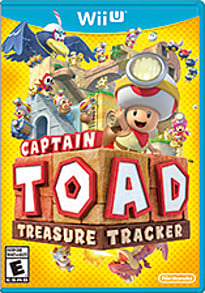Game Review
by Dave Riley,Captain Toad: Treasure Tracker
WiiU
| Description: |  |
||
Breaking out from Super Mario 3D World's bonus content, Captain Toad and Toadette tromp around dozens of treasure-seeking stages all their own. |
|||
| Review: | |||
Treasure Tracker is a simple game, built on the ultra-fun playhouses that Super Mario 3D World used for variety between its standard platforming levels. Captain Toad and Toadette trundle through bite-sized dioramas floating in space, grabbing up 1-ups and fistfuls of coins as they make their way to the star that clears the level.  It's not all that difficult. Sometimes you're deposited onto a speed-boosting raceway or made to speedily climb and escape an ever-rising poison lake or lava fountain, but few levels are white-knuckle tests of platforming acumen, mostly they're comfortable strolls. Both the Captain and Toadette possess an identical, extremely limited skillset. Without the ability to jump, their platforming is restricted to climbing ladders, turning cranks, and waiting for elevators. Without the ability to jump, they instead use Mario 2 turnips to clear paths and defeat foes. There aren't always enough turnips laying around to defeat every Shy Guy in his path, and so the levels sometimes become miniature stealth action sequences of sneaking around enemies--or quickly toddling out of their attack range, once they spot you and give chase--as you seek out optional golden mushrooms, coins, and diamonds. Though the diamonds are optional in name only; like Super Mario 3D world, you'll need to grab the majority of them to unlock later stages and actually finish the game. Finding the hidden diamonds adds a bit more challenge and depth, and provide a good enough excuse to poke and peek at the intricate, tiny places the designers made. This game isn't for beating your head against unsolvable riddles, it's for the simple wonder of exploring each wonderfully-realized microscopic world. It's for the constant feedback of seeing an obstacle and then immediately divining how to overcome it. Nintendo games are masters at making you feel smart, and this is a perfect realization of the form. You are only ever stumped for a second or two, before rotating the camera or shoving a platform or steering a Bullet Bill into a breakable block makes the way forward clear. This isn't a trying game--even being scrupulous about secrets, the average level takes about five minutes to puzzle out. Mostly, Captain Toad isn't there to stump you. It's a tangible, graspable box of wonder, a cakewalk mystery to unfold and enjoy at a leisurely pace.  Gamepad integration is fussy. With the camera tied to the tilt sensors, the world rotates every time you move the pad, and you're always moving the pad to raise and lower special blocks by tapping the screen or blowing into the mic. Almost nothing requires twitch reflexes, so the camera's drunken bobbling will rarely kill you or mess you up, it's just a little inconvenient. Most of the gamepad features are, really. Tapping the screen and blowing into the mic is a tactile way of bringing you into the game world, but doing so requires you take your attention off the screen, so levels that feature those kinds of mechanics force you to constantly reorient your viewpoint between gamepad and TV. It's fun tapping the screen to move around blocks, creating new paths or revealing hidden treasure. I wouldn't have wanted them to take it out, but a less-disorienting middle ground would've been nice. The basic pieces of any Mario game (speed boosters, falling donut blocks) make an appearance, as do the new bits and bobs from Super Mario 3D World. There's the cloning cherry that forces you to split your brain and send multiple Toads down different paths with only one analog input controlling all of them at the same time. The rhythmic disappearing/reappearing blocks also show up once or twice, their slow-poke timing made almost frantic by the Captain and Toadette's waddle-like maximum acceleration. When you finish the several dozen main levels a slew of cute, but lightweight, bonuses unlock, letting you truck through Super Mario 3D World's opening stage with the Captain's unique abilities or having you explore a previous level to gather the disparate members of the Toad exploration squad and guide them to the goal. The building blocks are familiar, but levels usually feel like they're asking you to do something new. Gimmicks are carefully meted out, nothing is overused. If anything, slight as the whole package feels, there could've been one or two levels more of each. A couple more Boo houses and Galaxy-style cloud planets would've been nice, given the game's only four or five hours long and even clearing all the hidden objectives will take seven or eight hours, tops.  But there's something to be said for short games, and Captain Toad is as breezy and easy-going a game as we've seen this year. What's more, it's charming. It exults in its simple, easy-to-grasp mechanics just as it does Toad's adorably annoying squeals and pratfalls. Rarely a struggle and never fraught, this is a good-natured game that doesn't sacrifice craft for the sake of accessibility. It's fun, but it's compelling; it's slow, but it's dense. Where so many modern games are explosive rollercoasters shuffling you from checkpoint to checkpoint with a velocity that never slows, only amplifies, there's no way to play Captain Toad but to take your time and look around. This is a game to enjoy at your own pace, provided that pace is "slow." There's no pressure here, there isn't even a timer--if there were, how could the Captain's pudgy little legs be expected to outrun it? |
| Grade: | |||
|
Overall : B+
Graphics : A-
Sound/Music : B+
Gameplay : A
Presentation : B
+ Enchanting levels that never repeat themselves |
|||
| discuss this in the forum (4 posts) | | |||